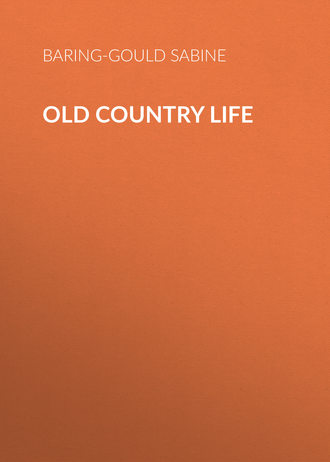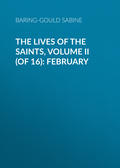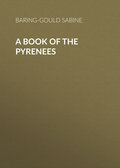
Baring-Gould Sabine
Old Country Life
CHAPTER IX
FAMILY PORTRAITS
ONE day a very grand and, as she conceived, original idea came into my grandmothers head. She was resolved to represent pictorially, on a sheet of cartridge-paper, all the confluent streams of blood in her children's veins, of the families to which they were entitled to draw blood through past alliances.
So my grandmother got out her ruler and colour-box, and a pallet and brushes, and filled a little glass with water. Presently a pedigree was drawn out by the aid of compasses and a parallel ruler. Then she rubbed her paints and set to work colouring. She dabbed some vermilion on Father A, and gamboge on Mother B; then on the next in the same generation, Father C, she put sage-green; and his wife, Mother D, she indicated with Prussian blue. The son of vermilion A and gamboge B was R. That was simple enough; in his arteries flowed a vivid tide of combined vermilion and gamboge. He married S, who was the offspring of sage-green C and Prussian blue D; consequently her arteries were flowing with rather a dingy mixture of sage-green and Prussian blue. Now R and S had a child, P, and his veins were charged with a combination of vermilion and gamboge and sage-green and Prussian blue.
When my grandmother had got so far, she bit the end of her paint-brush; for P, who was her husband's father, of course married, and her mother-in-law must be also represented by a combination of four colours. She took the end of the brush out of her mouth and rubbed emerald green and carmine. E and F should symbolize her husband's mother's grandparents. E brought into the family a stream of carmine blood, and F one of vivid emerald. Then the veins of her step-mother represented a mixed tide of carmine and emerald and of two other families, as yet unindicated. To these she promptly appropriated violet and orange. Now at last was she able to tabulate the constituents of her husband's blood; it was composed of minute rills of vermilion, gamboge, sage-green, Prussian blue, carmine, emerald green, violet, and orange. Already she had trenched on the composite colours. Now a great dismay fell on my grandmother; for she had to complete the same process for the exemplification of her own blood; and for her ancestry not only were no primary colours left, but even no secondary. She had to represent them with brown, lavender, slate, – yes, oh joy! there was another blue, cobalt! – verdegris, lemon yellow, black, and white. She hesitated some while before employing the verdegris. She never completed that table; for she was aghast at the rivers of mud, literal mud, which, according to her scheme, flowed through the arteries of her offspring. Now look at this table. Consider, it is only one of a pedigree through five generations.
Every one of my readers, every human being, nay, every beast, and bird, and fish, and reptile, represents the 16 ancestors of four generations, that means 32 independent streams of blood in the fifth generation, and 1004 currents in the tenth generation, and 32,128 rivulets of distinct blood in the fifteenth generation, and 1,028,096, if we go back to the twentieth generation. Take thirty years as a generation, then, in the reign of Henry III., there were over a million independent individuals, walking, talking, eating, marrying, whose united blood was to be, in 1889, blended in your veins. Why, that ogre of a sailor in the Bab Ballads, who represented a whole ship's crew, because, when shipwrecked, he had eaten them, is nothing to you. The whole population of London, of Middlesex, was not a million, then. You represent a large county – Yorkshire, for instance.
Our arteries are very sluices, through which an incredible amount of confluent rills unite to rush, the drainage of the whole social country-side.
Such being the case, does it not seem a farce to talk about family types, and family likenesses, and family peculiarities beyond one or two generations at most? And yet it is not a farce; for what comes out abundantly clear is, that certain streams are stronger than others, and colour and affect for several generations the quality of the blood with which they mingle. Not so only, but earlier types reappear after the lapse of time as distinct as though there had been no intermediate blood mixture, as though there had been filiation by gemmation, as is the case with sponges.
One day I was visiting a friend, when I was struck by the excellence of a portrait in his hall of a very refined and beautiful old lady; there was nothing characteristic in the dress. Being a fancier in portraiture, and being mightily ill-contented with modern portrait-painting, this picture pleased me especially; it was a picture as well as a portrait, harmonious in colour and tone, and artistically focussed. Moreover, it was a perfectly life-like "presentiment" of my friend's wife. He and she were both old people. Said I to my friend, "What an admirable likeness! The artist has not only made a good picture, but he has caught your wife's expression as well as features and peculiar colouring. Who is the painter? I did not know we had the man nowadays who could have painted such a portrait."
"Oh," he answered, "that is not my wife – it is her great-grandmother."
Thus the wife represented four united streams of two generations back, but she represented in face, and represented exactly, only one of them.
Now for another instance. In a certain family that I know intimately, a son and a female cousin are as much alike as though they were twin brother and sister; what is the more remarkable is, that they deviate altogether from the type of their brothers and sisters, parents, uncles, and aunts. But, and here is the curious fact, they resemble, even ludicrously, an ancestor whose miniature and portrait in oils are in the possession of the family. I draw out the pedigree. I must premise that the portrait is of a gentleman in forget-me-not blue velvet, and he goes in the family by the name of the Blue Man.
M and N are the cousins, male and female, who are as alike as twins, and they are exact reproductions of the Blue Man, notwithstanding that through C, D, G, and I come in fresh streams of blood, that two entirely independent rivers flush the veins of M and N respectively, coming in from G and I. They have the blood of C and D in common, but alike disregard their qualities; so also do they reject the blood of their respective mothers, and go back to a common ancestor in the reign of Queen Anne.
But I can give a still more remarkable instance of atavism, which also must be illustrated by a table. Here the likeness goes back even further, and, like that above, also through the maternal line.
There is in the same old manor-house as that in which hangs the Blue Man another picture, painted by Carlo Maratti, in or about 1672, of a certain Sir Edward, a dandy, in long flowing curls, a beautiful Steenkirk, a cherry ribbon round his neck, and also about his wrists. The face is fine, haughty, somewhat dreamy. It was painted of him when he was a young man of about five-and-twenty. Hanging near him is his elder brother, also with flowing hair, a bluff, good-natured man in appearance, quite different in character from the knight, one may judge, and certainly not like him in feature. Now the knight, Sir Edward, died without issue, and left all his property to his great-nephew, the grandson of his elder brother James. That nephew bought estates in Nottinghamshire, and for two hundred years the family he founded has been apart from the elder branch, which lives in the west of England, and which owns the picture.
One day recently there came into the neighbourhood a descendant of James, and calling at the house of his kinsman, unconsciously seated himself beneath the picture of Sir Edward. He was a young man of about four-and-twenty. He was at once greeted with an exclamation of astonishment and amusement. He was extraordinarily like the portrait; had he but been dressed in stamped black velvet, worn curls, a Steenkirk, and cherry ribbons, he might have been the same man. Now look at this pedigree, and note the remarkable fact. He did not hail from the knight, whom he resembled, but from his brother James, whom he did not resemble. The knight, Sir Edward, must therefore have inherited the features of an earlier ancestor, who was also, of course, the ancestor of his brother; so that this young man in 1888 bore the face and features of a still earlier member of the family, whose likeness has not been preserved, if it were ever taken. Here is a family likeness going back six or seven generations. We cannot be certain that the characteristic features of Sir Edward were derived from his father or his mother. Nor is this likeness found only in N. It exists also in his father L, though not in so strong a degree, or, at all events, it is less apparent in an old man of sixty than in a young man of four-and-twenty. Curiously enough, the portrait of Elizabeth, the ancestress through whom these two, L and N, derive their likeness to Sir Edward, shows none of these characteristics. They remained latent in her, but reappeared in her grandson and great-grandson. Unfortunately the pictures of D and F, who intervened, have not been preserved, or their whereabouts have not been discovered, so that it is not possible to track the likeness through two generations that intervene between Elizabeth in 1780 and James in 1680.
It has been conjectured that a child sitting daily in the presence of a certain portrait insensibly assumes a likeness to it; but such a conjecture will not satisfy the case just mentioned, for L and N till recently had never seen the picture which they so closely resembled.
There is another point connected with family portraits that has given me occasion of thought and speculation; and that is, the way in which those children who are named after an ancestor or ancestress sometimes, I do not say often or always, but certainly sometimes, do in a very remarkable manner receive the stamp of the features of that ancestor after whom named. This has nothing to do with the naming of the child at baptism because of a supposed resemblance, for in very young infants none such can be traced, but the likeness grows in the child to the person whose name it bears.
Now here is a bit of pedigree, with the likenesses that exist curiously agreeing with the Christian names. In this relation of a new generation to an old there is a point to be remarked. E2 is in character, in manner, and in tastes and pursuits exactly what E was, but does not resemble him in face. W D2 is just like W D, his great-great-great-grandfather, whose double Christian name he bears. M B2 and M B3 are like M B in face, and M B2 resembles her great-great-grandmother in face and in character. D A2 is absurdly like her great-grandmother, whose double name she bears, but is as yet too young for the mental characteristics to show themselves, or at all events to have become sufficiently emphasized to enable one to say whether, in mind as in face, she resembles her great-grandmother.
Now this may be accidental, but if so, it is a very curious and remarkable accident. Noticing it in other cases, I have sometimes wondered whether there may be in it more than accident. The old Norsemen believed that by calling a child after a certain great man, some of that great man's luck and spiritual force passed with his name to the child. The idea among Roman Catholic parents of giving their offspring the names of saints is, that they put the children under the special patronage, influence, and tutelage of the saint after whom they are called. Now – is there in these ideas anything more than a fancy, a delusion, a superstition? Is it possible that a mysterious effluence should pass from the spirit of the departed to the child that reproduces his or her name, and that this effluence should affect, modify, and impress the features and character of the child?
It is remarkable the way in which tricks perpetuate themselves. I know some one who, when a boy, had to be broken of the absurd habit of slapping the sole of his right boot with his right hand every now and then behind his back, as he walked. An old aunt saw him do this one day, and she said, "How odd! we had a world of trouble with his father when he was a child – about this very thing."
I may, in connection with this, mention a personal matter. My paternal grandfather's sister, Jacquetta Baring, married Sir Stafford Northcote, in 1791; she was the grandmother of the late Lord Iddesleigh, who was, accordingly, my cousin, but whom I never met. One day I was with one of his sons, who, whilst in conversation with me, laughed, and then said, "Excuse me, but there are many little ways you have, both of turn of the head and movements of the hand, that bring my father continually before my mind whilst you are speaking with me."
These little tricks of manner are therefore not personal, are not the result of association and imitation, but travel through the blood.
But to return to family portraits. That, in spite of the influx of fresh blood from all quarters, a certain family type remains, one can hardly doubt in looking through a genuine series of family pictures. I knew a case of an artist who had been employed in a certain house, where he had become familiar with the family portraits, which he had cleaned, relined and restored. Some of the early pictures of the family had been lost, in fact sold, by a spendthrift – another Charles Surface – who did not shrink from disposing of his mother's picture by Sir Joshua Reynolds. The head of the family knew where some two or three of these pictures had gone; they had been bought by a family akin to his, and the representative of that family very kindly acceded to his request that he might have them copied. The artist was sent to that gentleman's house to do what was desired. He was introduced into the dining-room, where hung over a score of portraits, but he went directly to the two which belonged to the family whose paintings he had cleaned, singled them out from the rest, and said, "These I am sure belong to the X – s. I know the type of face." He was right; he had spotted the only two which were not pictures of the A family, but were of the family X.
The delight of watching the re-emergence of a disappeared family likeness, as generations pass, is, no doubt, the chief delight of having a good series of family pictures. But there is an advantage in such a series which is not perhaps much considered, and that is the linking of the present generation in thought with the past. Since, with the Reformation, prayer for the dead ceased, our association with the world of the departed has fallen into total disregard, and we neither think of holding any communion of thought and good-will with our forebears, nor suppose that they can entertain any kindly thought of and wishes for us and our welfare. And yet, how much we owe them! Our beautiful estates, our dear old houses, the laying out of the parks and grounds, the cutting of the terraces, the digging of the ponds, the planting of the stately trees, the gathering together of our plate, our books, our pictures, our old furniture. Nay, more, if we have not inherited these, we have from them some twists in our mind, some terms in our speech, some physical or psychical characteristics, some virtues and some faults.
We owe to those old people more than we suppose. To their self-restraint, their guileless walk, their frugal ways, we owe our own hale bodies and strict consciences. Consider what misery a strain of tainted blood brings into a family – a strain of blood that carries vicious propensities with it. Well, if we have good in us, if we are scrupulous, honest, truthful, self-controlled, it comes to us in a large measure along with our pure blood from honest ancestry.
How can we sit in the beautiful halls and panelled boudoirs of the old people, and not be thankful to them for having made them so charming? How can we walk in the avenues they planted, pick the flowering shrubs they grouped and bedded, and not be grateful to them?
To plant a tree is a most unselfish work, for very few men live to see the trees they have planted reach such a size as to give pleasure to themselves. Men plant for their sons and grandsons; and their sons and grandsons who enjoy these trees should think for a moment of those to whose forethought they owe them. I confess I like, when I have enjoyed the beauty of some avenue, or clump of stately trees, to look at the picture of the planter of them, and say, "Thank you, dear old man, for the pleasure you have given to me, and will give to my children after me."
We have something yet to learn from the Chinese. The only religion of the Celestials is the worship of their ancestors. Every race probably inherits some truth that it can and is destined to impart to the world. The Chinese lack the deeper vision which can look up to the great Father of spirits above, but yet from them we may acquire thought of and love for our forebears.
"They are all gone into a world of light,
And I alone sit lingering here!
Their very memory is fair and bright,
And my sad thoughts does clear.
It glows and glitters in my cloudy breast,
Like stars upon some gloomy grove;
Or those faint beams in which this hill is dressed
After the sun's remove."
So sang Vaughan, a poet of the Restoration; and if one attempts it one can feel with him, that it is a pleasure and a rest to think of, and cultivate affection for, those of our family who belong to the past.
In many an old mansion the story goes that an ancestor or ancestress walks there, is to be seen occasionally between the glimpses of the moon visiting the old house, and generally as foretoken of some event intimately concerning the family. Such a story is common enough. We think that possibly these ancient ghosts may reappear to acquaint themselves how we are getting on, but it never occurs to us to visit them, and walk in spirit their desolate region, and cheer them with a kindly expression, and a word of good-will. Well, I think that a set of family portraits does help one to that, does link us somehow to these dead forefathers, and serves as a vehicle of mental communication between us.
Then, again, the family scamp is of use. We had one in our family. I am thankful to say we do not inherit his wild blood, as he died unmarried. He sold the bulk of the ancestral estates, and got rid of everything he could get rid of. But then – since his death he has stood as a warning to each successive generation. The children go before his picture and hear the story of his misdeeds, and it sinks into their hearts, and they learn frugality. They go over the acres that would have been theirs, but for the scamp; they see the old mansion, a quadrangle, which they would have had a dance about, had it not been for the scamp; they know that there are gaps in the series of family portraiture, because the pictures were sold by the scamp; and so they grow up with great fear in their minds lest they also should by any chance be even as he; and so the scamp is of good after all.
CHAPTER X
THE VILLAGE MUSICIAN
THE press and the railway are sweeping away all the old individualities and peculiarities that marked the country. It has been said, and said truly, that the railway has abolished everywhere in Europe a local cuisine, so that the traveller, whether in England, France, in Italy, Russia, at Constantinople, and even at Cairo, has the same menu at table-d'hôte. There was a time when, by travelling, you could pick up culinary ideas. That time is now past. You find exactly the same dishes, served in the same order, everywhere; and when fowl and salad come on, you know everywhere that the meat courses have arrived at their full stop. Costumes also are disappearing everywhere, no men now wear them, hardly any women, except a few artists' models on the steps of the Trinità at Rome, and a few German tourists who dress up like mountaineers when excursioning among the Tyrolean Alps.
It is said that the Chinese all dress alike, think alike, talk alike, act alike, eat the same food, take the same amusements, and look alike. Civilization is making us all Chinese, we are losing our individuality and our independence, and, it must be admitted, casting away behind us what constituted the picturesqueness and variety of life.
In the old times in country places, away from towns, there was much that was of interest; men and women had then quaint ways, stood out as characters, and impressed themselves on those who were around them. Now, all are afraid of being peculiar, of not being like every one else, of using a word, doing an act, thinking a thought which has not the sanction of – vulgarity, in the true acceptation of the term, according to its derivation – of being common.
One looks back, with a little compunction, on those old times. There was a freshness and charm about them which can never be recovered. Every one in a village knew every one else, and all his belongings; every one was related, and a stranger from a few miles off passed as a foreigner. To "go foreign" was to leave the parish. This was, of course, carried to extraordinary lengths in some places, and neighbouring villages regarded each other with traditional jealousy. This was not commendable. There is a story told of two villages, one called Mary Tavy, the adjoining called Peter Tavy, that is to say, St. Mary on the Tavy and St. Peter on the Tavy, on the borders of Dartmoor, that regarded each other for ages with animosity. One day after a storm of rain the river Tavy rolled down volumes of water, and a poor wretch was caught by the flood on a rock in mid-stream; he was unable to reach the bank. He screamed for assistance. Presently a man came along the side and halted, and called to the fellow in danger, "I say, be you a Peter Tavy or a Mary Tavy man?" "Peter Tavy," answered the wretch in danger. "Throw me a rope, or I shall be drownded." "No, no," answered he on the land, "I be a Mary Tavy man; so go on hollering till a Peter Tavy chap comes by;" and he left the fellow in distress to his fate.
This exclusiveness had its bad side, but it had its redeeming side also. There can be no question that the force of popular feeling, the sense of relationship, the feeling of belonging to a certain village, or class, did act as a strong moral support to many a young man and woman. They felt that they dared not bring disgrace on their whole class, or village, by misconduct. The sense of belonging to, being one member of a community, in which, if one member were honoured, all the members rejoiced with it, and if one were disgraced, the humiliation fell on all, was very strong and tough. That is to an immense extent gone, and can never be restored. We are all cosmopolitan now, and live and die to ourselves.
But let us come to some of the peculiar features of old village life, before there were railways, and when the post did not come every day.
At that time most villages had their feasts, revels, harvest homes, ringers' suppers, shearing feasts, and other entertainments. Some of us can remember when in the village churches the gallery was occupied by the village band, fiddles and viol, ophicleide, flute &c. They were done away with, and the hand-organ took its place in some churches, a real organ or a harmonium in others. It was a sad mistake of the clergy to try to abolish the old orchestra; – no doubt the playing was not very good, and the instruments were out of tune; no doubt also there was much quarrelling and little harmony among the performers, but an institution should be improved, not abolished. That gave the death-blow to instrumental music in our villages. Previously the smallest village had its half-dozen men who could play on some instruments. Now you find that there are half a dozen boys who can manage the concertina – that is all.
These instrumentalists attended all the festivities in a village, wakes, harvest homes, revels, and weddings, and were well received and well treated. They played old country dances, old ballads, old concerted pieces of no ordinary merit. In some parish chests may be found volumes of rudely written music, which belonged to these performers, mostly sacred, but not always so.
When in 1617 James I. was making a progress through Lancashire, he found that the Puritan magistrates had prohibited and unlawfully punished the people for using their "lawful recreations and honest exercises" on holidays; and next year he issued a declaration concerning sports and merry-makings, such as May-games, morris-dances, Whitsun-ales, the setting up of maypoles; and James very wisely said, "If these be taken away from the meaner sort, who labour hard all the week, they will have no recreations at all to refresh their spirits; and in place thereof it will set up filthy tipplings and drunkenness, and breed a number of idle and discontented speeches in their ale-houses." Also it would "hinder the conversion of many, whom their priests will take occasion hereby to vex, persuading them that no honest mirth or recreation is lawfully tolerable in our religion."
At the present day we hardly realize the extent to which music was cultivated in old times, so that England – not Italy, Germany, or France – was the great musical nation of Europe. What astonished foreigners, when they visited England in the reign of Henry VIII. and Elizabeth, was the perfection to which music was brought here, and the widespread knowledge of music that prevailed. France had its music school created by Sully, a Florentine by birth, who was placed at the head of a band of violins by Louis XIV. At that time "not half the musicians of France were able to play at sight." Even that band, got together with difficulty, could play nothing at sight. Nor did Sully effect any great reform in this respect, for when the Regent, Duke of Orleans, wished to hear Corelli's sonatas, which were newly brought from Rome, no three persons were to be found in Paris who could play them, and he was obliged to content himself with having them sung to him by three voices. On the other hand, in England at that time every gentleman was expected to be able either to sing a part at sight, or play a part on some instrument or other. As a regular thing after supper, the party in a country house adjourned to the music-room, and there spent the rest of the evening in singing or in instrumental music. Nor was this knowledge of music confined to the upper classes. A curious instance of this we find in Pepys' diary. That diary extends between the years 1660-1669. In the course of his diary, four maids are mentioned as being in his household, to attend on his wife, and a boy who waited on himself. All of these seem to have possessed, as an ordinary qualification, some musical skill and knowledge. Of the first of the serving-maids he says (November 17, 1662), "After dinner, talking with my wife, and making Mrs. Gosnell (the maid) sing – I am mightily pleased with her humour and singing." And again, on December 5, "She sings exceedingly well." Within a few months Gosnell was succeeded by Mary Ashwell; and he tells us in March, "I heard Ashwell play first upon the harpsicon, and I find she do play pretty well. Then home by coach, buying at the Temple the printed virginal book for her." The harpsicon and the virginal were the pianofortes of the period, something like square pianos; in the virginal the strings were struck by quills. Of the third maid Mrs. Pepys had, Mary Mercer, he says on September 9, 1664, that she was "a pretty, modest, quiet maid. After dinner my wife and Mercer, Tom (the boy) and I, sat till eleven at night, singing and fiddling, and a great joy it is to see me master of so much pleasure in my house. The girle (Mercer) plays pretty well upon the harpsicon, but only ordinary tunes, but hath a good hand; sings a little, but hath a good voyce and eare. My boy, a brave boy, sings finely, and is the most pleasant boy at present, while his ignorant boy's tricks last, that ever I see." After some time Mercer went to see her mother, and Mrs. Pepys, finding her absent without leave, went after her, found her in her mother's house, and there beat her. The mother having urged that Mary was "not a common prentice girl," and therefore ought not to have been thus chastized, Mrs. Pepys construed it into a question of her right to inflict corporal chastisement, and dismissed Mary.
In October, 1666, says Pepys, "my wife brought a new girle. She is wretched poor, and but ordinary favoured, and we fain to lay out seven or eight pounds worth of clothes upon her back: and I do not think I can esteem her as I could have done another, that had come fine and handsome; and, which is more, her voice, through want of use, is so furred that it do not at present please me; but her manner of singing is such that I shall, I think, take great pleasure in it."
After a while Mary Mercer was taken back, and then we hear of singing on the water, especially after a trip to Greenwich when returning by moonlight. The boy Tom was usually of the party. Of him Pepys says (Oct. 25, 1664), "My boy could not sleep, but wakes about four in the morning, and in bed laying playing on his lute till daylight, and it seems did the like last night, till twelve o'clock." And again, Dec. 26, 1668, "After supper I made the boy play upon his lute, and so, my mind is mighty content, – to bed."
We do not in the least suppose that Pepys' household was singular in the respect of having a succession of musical servants. All people in those times were musical – men, boys, women, and girls, of all classes and degrees. At the fire of London in 1666, Pepys, who was an eye-witness, tells us that the Thames was full of lighters and boats taking in goods, and that he "observed that hardly one lighter or boat in three, that had the goods of a house, but there was a pair of virginals in it."







